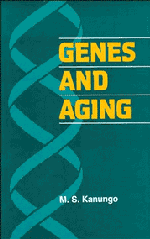5 - Changes in gene expression during aging
Published online by Cambridge University Press: 22 March 2010
Summary
Phenotypic changes that occur in an organism after the attainment of adulthood may be traced to the changes in specific proteins/enzymes that are coded by specific genes. For example, changes in the cell membrane that alter its permeability may be due to changes in its lipid components, which are synthesized by specific enzymes. The turnover of collagen decreases with age because the level of collagenase declines. This increases cross-linking between collagen fibrils and in turn the tensile strength of collagen. Wrinkling of the skin in mammals is the result of these changes. During aging, a decrease in the enzyme tyrosinase leads to greying of the hair in mammals. The level of free radicals that damage macromolecules increases with age because superoxide dismutase (SOD) which is coded by a gene decreases. Thus, the functional changes that occur as an organism ages, whether at the organ or cellular or molecular level, are due to specific enzymes that are coded by specific genes. Environmental and intrinsic factors, however, influence the rate and the degree of such changes. Nevertheless, the fact that all individuals of a species have a specific life-span pattern indicates that the primary reason for a functional change is due to one or more genes. Therefore, an understanding of the changes in gene expression during aging may throw light on the basic cause of this process.
Information
- Type
- Chapter
- Information
- Genes and Aging , pp. 167 - 245Publisher: Cambridge University PressPrint publication year: 1994
Accessibility standard: Unknown
Why this information is here
This section outlines the accessibility features of this content - including support for screen readers, full keyboard navigation and high-contrast display options. This may not be relevant for you.Accessibility Information
- 4
- Cited by
